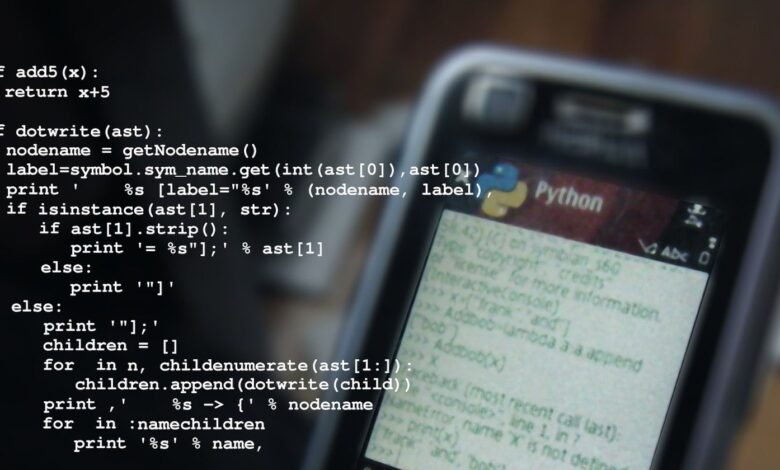The Python Commands Cheat Sheet for Budding Programmers

The use of Python to solve various tech problems and its easy learning curve has made it one of the most popular modern programming languages. Despite being quick to learn, its regular expressions can be tricky, especially for newcomers.
Although Python has a lot of libraries, it’s wise that you know your way around its regular syntaxes. Even if you’re an expert at it, there’s a chance that you still need to occasionally look up some Python commands to refresh your memory.
For that reason, we’ve prepared this Python regular expressions cheat sheet to help you get a better hold of your syntaxes.
FREE DOWNLOAD: This cheat sheet is available as a downloadable PDF from our distribution partner, TradePub. You will have to complete a short form to access it for the first time only. Download the Python Commands Cheat Sheet for Budding Programmers.
The Python Commands Cheat Sheet for Budding Programmers
Expression | Action | Examples |
|---|---|---|
print() | Display the result of a command | x=”Hello world” print(x) output: Hello world |
input() | Collect inputs from users | print(input(“what is your name?”)) output: what is your name? |
type() | Find the type of a variable | x=”Regular expressions” type(x) output: |
len() | Find the number of items in a variable | len([1, 2, 3]) output: 3 |
\ | Escape a character that changes the intent of a line of code | print(“I want you to add\”\””) output: I want you to add”” |
\n | Break a string character to start on the next line | print(“This is a line \n This is a second line”) output: This is a line This is a second line |
def function_name(parameter): commands | Initiate a function with an optional parameter | def yourName(x): print(x+1) |
lambda | Call an anonymous function | add_3_to = lambda y: y+3 print(add_3_to(4)) output: 7 |
return | Return a result from a function | def yourName(x): return x+1 |
class | Create a Python object | class myClass: def myFunc(x): |
def __init__ | Initialize the attrributes of a class | class myClass: def __init__(self, attributes…) |
“__init__.py | Save a file containing a module so that it’s read successfully in another Python file | Rename a file containing a module as: “__init__.py |
int() | Convert a variable to integer | int(1.234) output: 1 |
str() | Convert a variable to string | str(1.234) output: ‘1.234’ |
float() | Convert a variable to float | float(23) output: 23.0 |
dict(Counter()) | Convert a list or a tupple into a dictionary after sorting with a Python built-in Counter | from collections import Counter dict(Counter([1,1,2,1,2,3,3,4])) output: {1: 3, 2: 2, 3: 2, 4: 1} |
round() | Round up the output of an operation to the nearest whole number | round(23.445) output: 23 |
round(operation or number, decimal places) | Round up the output of an operation to a specific number of decimal places | round(23.4568, 2) output: 23.46 |
if: | Initiate a conditional statement | if 2<3: print(“Two is smaller”) |
elif: | Make a counterstatement when the if statement is False | if 2<3: print(“Two is smaller”) elif 2==3: print(“Go on”) |
else: | Make a final counterstatement if other conditions are False | if 2<3: print(“Two is smaller”) elif 2==3: print(“Go on”) else: print(“Three is greater”) |
continue | Ignore a condition and execute the rest of the loop | a=[1, 4, -10, 6, 8] for b in a: if b<=0: continue print(b) output: 1 4 6 8 |
break | Terminate the flow of a loop with a given condition | a=[1, 4, -10, 6, 8] for b in a: if b>=6: break print(b) output: 1 4 -10 |
pass | Ignore a set of prior instructions | for b in a: pass |
try, except | Try a block of code, else, raise a defined exception | try: print(a) except: print(“An error occured!”) output: An error occured! |
finally | Execute a final code when the try and the except blocks fail | try: print(a) except: print(d) finally: print(“You can’t print an undefined variable”) output: You can’t print an undefined variable |
raise Exception() | Raise an exception that stops the command when execution isn’t possible | a=7+2 if a<10: raise Exception(“Oh! You didn’t get a score of 10”) |
import x | Import a whole module or library | import math |
from x import y | Import a library x from a file, or a class y | from scipy.stats import mode |
as | Customize an expression to your preferred name | import pandas as pd |
in | Check if a value is present in a variable | x=[1, 4, 6, 7] if 5 in x: print(“There is a five”) else: print(“There is no five”) output: There is no five |
is | Check if two variables refer to a single element | x=[1, 4, 6, 7] x=b print(x is b) True |
None | Declare a null value | x=None |
< | Check if one value is lesser than another | 5<10 output: True |
> | Check if one value is more than another | 5>10 output: False |
<= | Check if a value is lesser or equal to another | 2*2<=3 output: False |
>= | Check if a value is greater or equal to another | 2*2>=3 output: True |
“== | Check if a value is exactly equal to the other | 3==4 ouput: False |
!= | Ascertain that a value is not equal to the other | 3!=4 ouput: True |
import re | Import Python’s built-in regular expressions | import re re.findall(“strings”, variable) |
a|b | Check if either of two elements are present in a string | import re someText=”Hello regular expression” a=re.findall(“regular|Hello”, someText) print(a) output: [‘Hello’, ‘regular’] |
string$ | Check if a variable ends with a set of strings | import re someText=”Hello regular expression” a=re.findall(“expression$”, someText) output: [‘expression’] |
^string | Check if a variable starts with a set of strings | import re someText=”Hello regular expression” a=re.findall(“^Hello”, someText) print(a) output: [‘Hello’] |
string.index() | Check the index position of a string character | a= “Hello World” a.index(‘H’) output: 0 |
string.capitalize() | Capitalize the first character in a set of strings | a= “Hello World” a.capitalize() output: ‘Hello world’ |
string.swapcase() | Print the first letter of each word as a lower case and the others as upper case | a= “Hello World” a.swapcase() output: ‘hELLO wORLD’ |
string.lower() | Convert all the strings to a lowercase | a= “Hello World” a.lower() output: ‘hello world’ |
string.upper() | Convert all strings to uppercase | a= “Hello World” a.upper() output: ‘HELLO WORLD’ |
string.startswith() | Check if a string starts with a particular character | a= “Hello World” a.startswith(‘a’) output: False |
string.endswith() | Check if a string ends with a particular character | a= “Hello World” a.endswith(‘d’) output: True |
string.split() | Separate each word into a list | a= “Hello World” a.split() output: [‘Hello’, ‘world’] |
strings {}’.format() | Display an output as string | a=3+4 print(“The answer is {}”.format(a)) output: The answer is 7 |
is not None | Check if the value of a variable is not empty | def checknull(a): if a is not None: return “its full!” else: return “its empty!” |
x%y | Find the remainder (modulus) of a division | 9%4 output: 1 |
x//y | Find the quotient of a division | 9//4 output: 2 |
“= | Assign a value to a variable | a={1:5, 3:4} |
“+ | Add elements together | [“a two”] + [“a one”] output: [‘a two’, ‘a one’] 1+3 output=4 |
“- | Find the difference between a set of numbers | 3-4 output=-1 |
“* | Find the product of a set of numbers | 3*4 output:12 |
a+=x | Add x to variable a without assigning its value to a new variable | a=2 a+=3 output: 5 |
a-=x | Subsract x from variable a without assigning it to a new variable | a=3 a-=2 output: 1 |
a*=x | Find the product of variable a and x without assigning the resullt to a new variable | a=[1, 3, 4] a*=2 output: [1, 3, 4, 1, 3, 4] |
x**y | Raise base x to power y | 2**3 output: 8 |
pow(x, y) | Raise x to the power of y | pow(2, 3) output: 8 |
abs(x) | Convert a negative integer to its absolute value | abs(-5) output: 5 |
x**(1/nth) | Find the nth root of a number | 8**(1/3) output: 2 |
a=b=c=d=x | Assign the same value to multiple variables | a=b=c=d=”Hello world” |
x, y = y, x | Swap variables | x = [1, 2] y = 3 x, y = y, x print(x, y) output: 3 [1, 2] |
for | Loop through the elements in a variable | a=[1, 3, 5] for b in a: print(b, “x”, “2”, “=”, b*2) output: 1 x 2 = 2 3 x 2 = 6 5 x 2 = 10 |
while | Keep looping through a variable, as far as a particular condition remains True | a=4 b=2 while b<=a: print(b, “is lesser than”, a) b+=1 output: 2 is lesser than 4 3 is lesser than 4 4 is lesser than 4 |
range() | Create a range of positive integers between x and y | x=range(4) print(x) range(0, 4) for b in x: print(b) output: 0 1 2 3 |
sum() | Iterate through the elements in a list | print(sum([1, 2, 3])) output:6 |
sum(list, start) | Return the sum of a list with an added element | print(sum([1, 2, 3], 3)) output: 9 |
| [] | Make a list of elements | x=[‘a’, 3, 5, ‘h’, [1, 3, 3], {‘d’:3}] |
() | Create a tupple—tupples are immutable | x=(1, 2, ‘g’, 5) |
{} | Create a dictionary | a={‘x’:6, ‘y’:8} |
x[a:b] | Slice through a list | x=[1, 3, 5, 6] x[0:2] output: [1, 3] |
x[key] | Get the value of a key in dictionary x | a={‘x’:6, ‘y’:8} print(a[‘x’]) output: 6 |
x.append() | Add a list of values to an empty list | x=[1] x.append([1,2,3]) print(x) output: [1, [1,2,3]] |
x.extend() | Add a list of values to continue an existing list without necessarily creating a nested list | x=[1,2] x.extend([3,4,6,2]) print(x) output: [1, 2, 3, 4, 6, 2] |
del(x[a:b]) | Delete an item completely from a list at a specific index | x=[1,2,3,5] del(x[0:2]) print(x) output: [2,3,5] |
del(x[key]) | Delete a key and a value completely from a dictionary at a specific index | y={1:3, 2:5, 4:6, 8:2} del(y[1], y[8]) print(y) output= {2:5, 4:6} |
dict.pop() | Pop out the value of a key and remove it from a dictionary at a specific index | a={1:3, 2:4, 5:6} a.pop(1) output: 3 |
dict.popitem() | Pop out the last item from a dictionary and delete it | a={1:2, 4:8, 3:5} a.popitem() output: (3, 5) print(a) output: {1:2, 4:8} |
list.pop() | Pop out a given index from a list and remove it from a list | a=[1, 3, 2, 4, 1, 6, 6, 4] a.pop(-2) output: 6 print(a) output: [1, 3, 2, 4, 1, 6, 4] |
clear() | Empty the elements of a list or a dictionary | x=[1, 3, 5] x.clear() print(x) output: [] |
remove() | Remove an item from a list | x=[1, 5, 6, 7] x.remove(1) output: [5, 6, 7] |
insert() | Insert elements into a llist | x=[3, 5, 6] x.insert(1, 4) print(x) output: [1, 4, 3, 5, 6] |
sort(reverse=condition) | Reverse the direction of the elements in a list | x=[1, 3, 5, 6] x.sort(reverse=True) print(x) output: [6, 5, 3, 1] |
update() | Update a dictionary by changing its first element and adding any other item to its end | x={1:3, 5:6} x.update({1:4, 8:7, 4:4}) print(x) output: {1: 4, 5: 6, 8: 7, 4: 4} |
keys() | Show all the keys in a dictionary | a={1:2, 4:8} a.keys() output: dict_keys([1, 4]) |
values() | Show all the values in a dictionary | a={1:2, 4:8} a.values() output: dict_values([2, 8]) |
items() | Display the keys and the values in a dictionary | a={1:2, 4:8} a.items() output: dict_items([(1, 2), (4, 8)]) |
get(key) | Get the value of an item in a dictionary by its key | a={1:2, 4:8, 3:5} a.get(1) output: 2 |
setdefault(key) | Return the original value of an element to a dictionary | a.setdefault(2) |
f={**a, **b} | Merge two dictionaries | a={‘x’:6, ‘y’:8} b={‘c’:5, ‘d’:3} f={**a, **y} print(f) output:{‘x’: 6, ‘y’: 8, ‘c’: 5, ‘d’: 3} |
remove() | Remove the first matching value of an element from a list without minding its index | a=[1, 3, 2, 4, 4, 1, 6, 6, 4] a.remove(4) print(a) output: [1, 3, 2, 4, 1, 6, 6, 4] |
memoryview(x) | Access the internal buffers of an object | a=memoryview(object) |
bytes() | Convert a memory buffer protocol into bytes | bytes(a[0:2]) |
bytearray() | Return an array of bytes | bytearray(object) |
# | Write a single line of comment or prevent a line of code from being executed | # Python regex cheat sheet |
“”” “”” | Write a multi-line comment | “””The Python regex cheat sheet is good for beginners It’s equally a great refresher for experts””” |
Command Line | ||
pip install package | Install an online library | pip install pandas |
virtualenv name | Use virtaulenv to create a virtual environment | virtualenv myproject |
mkvirtualenv name | Use virtual environment wrapper to create virtual environment | mkvirtualenv myproject |
python file.py | Run the commands in a Python file | “python my_file.py |
pip freeze | List out all the installed packages in a virtual environment | pip freeze |
pip freeze > somefiles | Copy all installed libraries in a single file | pip freeze > requirements.txt |
where | Find the installation path of Python | where python |
–version | Check the version of a package | python –version |
.exe | Run a Python shell | python.exe |
with open(file, ‘w’) | Write to an existing file and overwrite its existing content | with open(‘regex.txt’, ‘w’) as wf: wf.write(“Hello World!”) |
with open(file, ‘r’) | Open a file as read-only | with open(‘regex.txt’, ‘r’) as rf: print(rf.read() |
with open(file, ‘a’) | Write to a file without overwriting its existing content | with open(‘regex.txt’, ‘a’) as af: af.write(“\nHello Yes!”) |
file.close | Close a file if it’s not in use | af=open(‘regex.txt’) af.close |
exit | Exit the Python shell | exit() |
Get Creative When Using Python
Learning Python’s regular expressions is a big step towards becoming a better Python programmer, but that’s just one of the few things you need to do.
However, playing around with its syntaxes and getting creative with them polishes your coding skill. So beyond learning the syntaxes, use them in real-life projects and you will become a better Python programmer.






